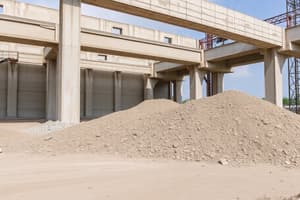Podcast
Questions and Answers
What is the primary purpose of the International Code on Intact Stability (IS Code)?
What is the primary purpose of the International Code on Intact Stability (IS Code)?
- To standardize buoyancy aid design for passenger ships
- To regulate maritime trade practices
- To ensure the safe operation of ships by setting stability criteria (correct)
- To designate no anchoring zones in sensitive marine ecosystems
When did the 2008 IS Code take effect?
When did the 2008 IS Code take effect?
- December 31, 2009
- July 1, 2008
- July 1, 2010 (correct)
- January 1, 2010
What type of ships does the IS Code apply to?
What type of ships does the IS Code apply to?
- Only passenger ships and cargo ships
- Only tankers and bulk carriers
- A wide range of ships, including cargo ships, passenger ships, fishing vessels, and offshore rigs (correct)
- Only fishing vessels and offshore rigs
What is the significance of January 1, 2010, in relation to the IS Code?
What is the significance of January 1, 2010, in relation to the IS Code?
What is the status of the IS Code's minimum stability standards?
What is the status of the IS Code's minimum stability standards?
What international organization sets the intact stability requirements through the IS Code?
What international organization sets the intact stability requirements through the IS Code?
What is the primary focus of the Intact Stability Code (IS Code) developed by IMO?
What is the primary focus of the Intact Stability Code (IS Code) developed by IMO?
In which year did the Maritime Safety Committee adopt the International Code on Intact Stability?
In which year did the Maritime Safety Committee adopt the International Code on Intact Stability?
What is the purpose of the weather criterion in the IS Code?
What is the purpose of the weather criterion in the IS Code?
What was the outcome of the 85th session of the Maritime Safety Committee?
What was the outcome of the 85th session of the Maritime Safety Committee?
When did the mandatory implementation of the 2008 IS Code come into effect?
When did the mandatory implementation of the 2008 IS Code come into effect?
What is the purpose of the righting lever (GZ) criterion in the IS Code?
What is the purpose of the righting lever (GZ) criterion in the IS Code?
What is the primary purpose of the International Code on Intact Stability (IS Code)?
What is the primary purpose of the International Code on Intact Stability (IS Code)?
What is the significance of the 2008 IS Code?
What is the significance of the 2008 IS Code?
What is the mandatory requirement for ensuring intact stability according to the MSC.75(69) resolution?
What is the mandatory requirement for ensuring intact stability according to the MSC.75(69) resolution?
Which of the following is a result of the adoption of Resolution MSC.267(85)?
Which of the following is a result of the adoption of Resolution MSC.267(85)?
What is the status of Part A of the 2008 IS Code under the International Convention for the Safety of Life at Sea (SOLAS) and the Protocol of 1988 relating to the International Convention on Load Lines?
What is the status of Part A of the 2008 IS Code under the International Convention for the Safety of Life at Sea (SOLAS) and the Protocol of 1988 relating to the International Convention on Load Lines?
What is the benefit of the International Code on Intact Stability (IS Code) for ship designers and operators?
What is the benefit of the International Code on Intact Stability (IS Code) for ship designers and operators?
Flashcards are hidden until you start studying
Study Notes
International Code on Intact Stability (IS Code)
- The IS Code provides mandatory and recommended stability criteria for ensuring the safe operation of ships.
- The main purpose of the IS Code is to minimize the risk of capsizing, injury to people on board, damage to the ship, and pollution to the environment.
History of the IS Code
- The IS Code was first developed in 1993 (resolution A.749(18)) and later amended in 1998 (resolution MSC.75(69)).
- The 2008 IS Code was adopted in 2008, taking into account technical developments and updates.
Key Provisions of the IS Code
- The IS Code sets minimum stability standards for ships, ensuring their safety during intact conditions.
- The code includes fundamental principles such as general precautions against capsizing, weather criterion, effect of free surfaces and icing, and watertight integrity.
- The code also addresses operational aspects like information for the master, including stability and operating booklets, and operational procedures in heavy weather.
Implementation of the IS Code
- The 2008 IS Code came into effect on July 1, 2010, upon the entry into force of the respective amendments to SOLAS and the Load Lines Protocol.
- The code applies to a wide range of ships, including cargo ships, passenger ships, fishing vessels, and offshore rigs.
Mandatory Requirements and Recommended Provisions
- The IS Code contains both mandatory regulations and recommended provisions, which significantly influence ship design and overall safety.
- Part A of the 2008 IS Code became mandatory under the International Convention for the Safety of Life at Sea (SOLAS) and the Protocol of 1988 relating to the International Convention on Load Lines.
Studying That Suits You
Use AI to generate personalized quizzes and flashcards to suit your learning preferences.





